Enhancing Kiyi (Coregonus kiyi) research to support the conservation and restoration of deep-water coregonine diversity in the Laurentian Great Lakes
Contributing Authors
Amanda Ackiss (USGS, aackiss@usgs.gov), Kris Dey (Little traverse Bay Band of Odawa Indians), Marc Chalupnicki (USGS), Michael Diefenbach (Little traverse Bay Band of Odawa Indians), Matt Herbert (TNC), Andrew Honsey (USGS), Gary Michaud (Little traverse Bay Band of Odawa Indians), Brian O’Malley (USGS), Jason Smith (Sault Ste Marie Tribe of Chippewa Indians)
Project Description
The deep-water coregonines of the Coregonus species complex (including C. hoyi, C. kiyi, C. nigripinnis, C. zenithicus, C. johannae, and C. reighardi) in the Laurentian Great Lakes were among the fishes most impacted by overfishing, invasive species, and habitat degradation in the 20th century (Eshenroder et al. 2016). Among the four lakes with extant populations of ciscoes, no remaining deep-water forms persist in Lake Ontario (though stocking efforts are underway to reintroduce Bloater C. hoyi) and Bloater is the only remaining deep-water coregonine in Lakes Michigan and Huron. Lake Superior retains the largest proportion of its historic deep-water coregonine diversity, with common occurrences of Bloater and Kiyi C. kiyi and rare occurrences of Shortjaw Cisco C. zenithicus. Kiyi is the most abundant coregonine in Lake Superior at depths >100m, with an estimated adult population size in 2011 of 384 million fish, more than double the estimated population size of Cisco C. artedi (Yule et al., 2013). The abundance of Kiyi in Lake Superior makes it a high-value target for restoring extirpated populations in Lakes Michigan, Huron, and Ontario, and managers from at least Lakes Ontario and Michigan have informally provided strong interest in reintroducing Kiyi should feasibility be demonstrated and concerns about hybridization with other deep-water coregonines be reduced.
One of the largest feasibility challenges to a Kiyi stocking program is how to collect viable spawning adults during winter from depths >100m in Lake Superior. Additionally, optimal rearing practices for deep-water species are relatively unknown since there is only one instance of Kiyi being maintained in a hatchery; in December 1960, spawning Kiyi were collected off the Apostle Islands in Lake Superior, and the gametes of 13 of those fish were mixed to create progeny that were reared from 1961-1963 at the Northville Hatchery in Michigan (Todd et al. 1981).
Since 2016, the USGS Lake Superior Biological Station and The Nature Conservancy have contracted with a commercial fisherman to survey deep-water ciscoes annually off Grand Island, MI in Lake Superior. The objective of that project was to determine when and where Kiyi spawn to inform future gamete collections. This past winter, the first attempt in 60 years to make wild-collected Kiyi progeny occurred during the Grand Island surveys in collaboration with fisheries scientists from the Little Traverse Bay Band of Odawa Indians (LTBBOI) and the Sault Ste. Marie Tribe of Chippewa Indians. Disease testing was done in December 2020, and a total of 29 crosses were attempted from fishes collected east of Grand Island in January 2021. Progeny were reared at the LTBBOI hatchery in Levering, MI, and ~2500 eggs from 15 pairings survived to eye-up. Eyed-up eggs from 12 of these pairings were transferred to the USGS Great Lakes Science Center (GLSC) wet lab in Ann Arbor MI, eggs from 3 pairings were transferred to the GLSC Tunison wet lab in Cortland NY, and eggs from 2 pairings were kept at the LTBBOI hatchery. Mortality was high across all facilities, and to date, ~40 progeny from a single family that was split between Ann Arbor and Tunison (a Kiyi x Bloater F1 cross) have survived.
Though this F1 cross was a result of species misidentification, Kiyi x Bloater hybrids provide valuable research opportunities to examine the potential for introgression with locally adapted species or populations if Kiyi from Lake Superior were introduced to other lakes. Hybridization among deep-water forms as populations in the 20th century declined has been proposed as a possible mechanism for the loss of Lake Huron’s deep-water coregonine diversity (Eshenroder et al. 2016) but remains untested, underscoring the importance of assessing hybrid viability in ciscoes. This current hybrid family and future hybrid crosses will allow us to begin the process of directly assessing the viability of Kiyi hybrids and will serve as research brood stocks for studying the mechanisms that prevent or enable successful backcrossing.
Here, we request support for new attempts to rear wild-collected Kiyi and Kiyi-hybrid progeny from upcoming Grand Island winter surveys. The first attempt at creating Kiyi progeny provided valuable information for optimizing the success of future efforts. For example, differentiation of Bloater and Kiyi in the field proved challenging due to overlapping variation in characters commonly used for distinguishing these species (e.g. pelvic fin length). Genetic identification of the parents used in the 29 pairings indicated that many of the attempted Kiyi pairings were Kiyi-Bloater hybrids or inadvertent Bloater x Bloater pairings. Egg quality was also a limiting factor, and alternative locations or depths may produce higher quality eggs. Proposed modifications include additional field training on Bloater and Kiyi identification prior to winter surveys, sampling at deeper depths and alternate sites off NW Grand Island known to have spawning populations of Kiyi, and attempting crosses in December (replicating Todd et al. 1981) in addition to January to reduce the chances of unintended Bloater-hybrids or Bloater x Bloater pairings.
